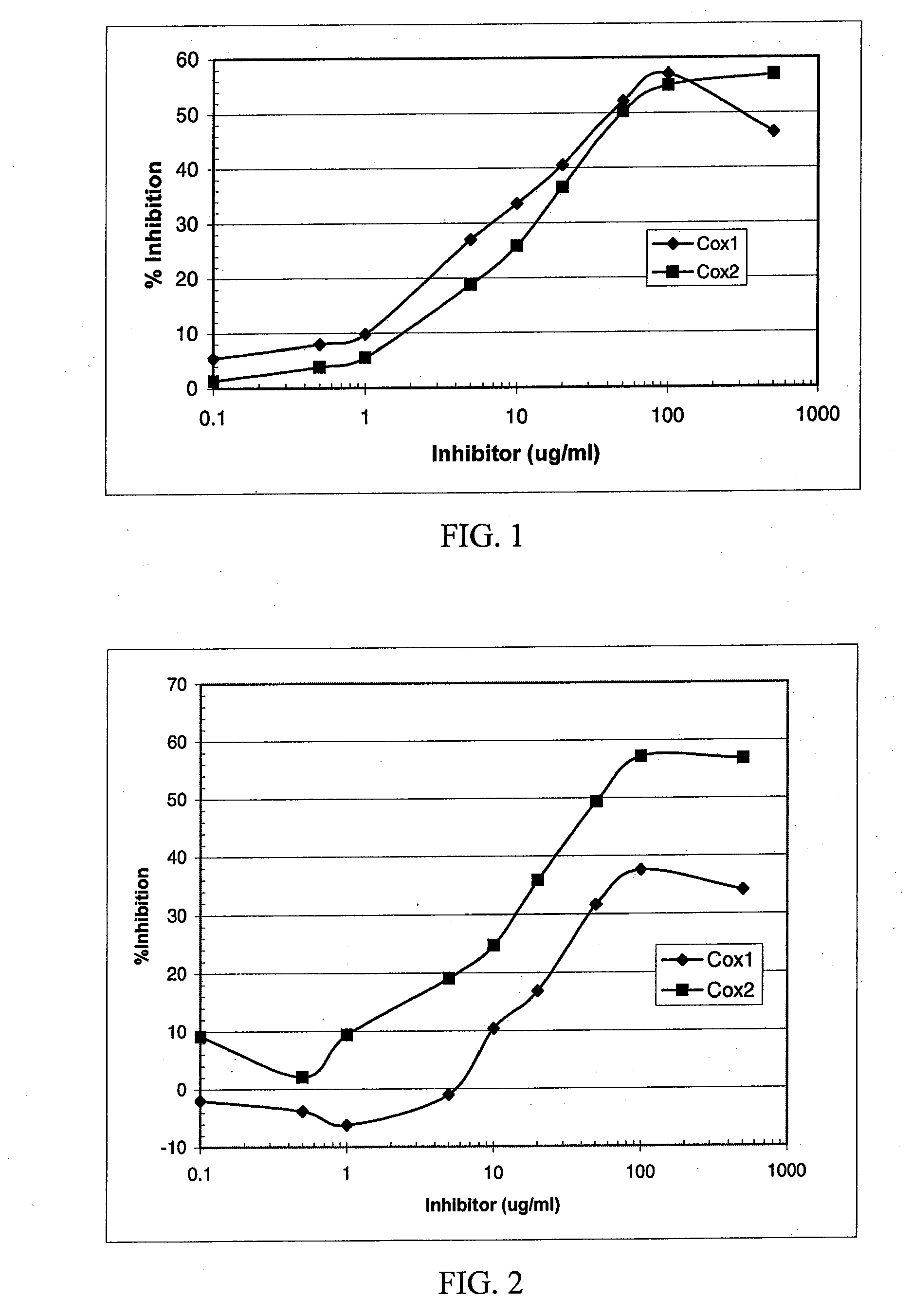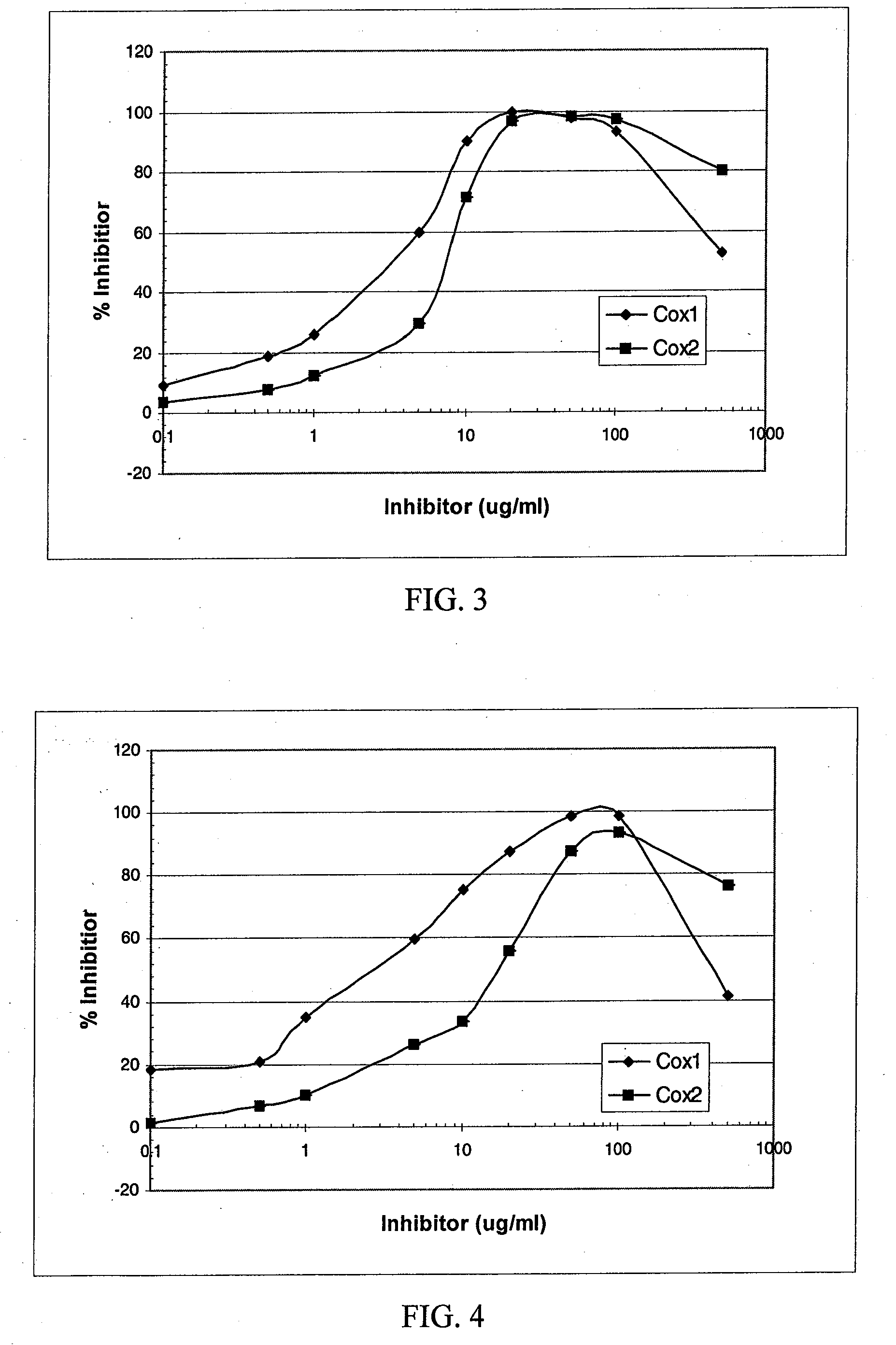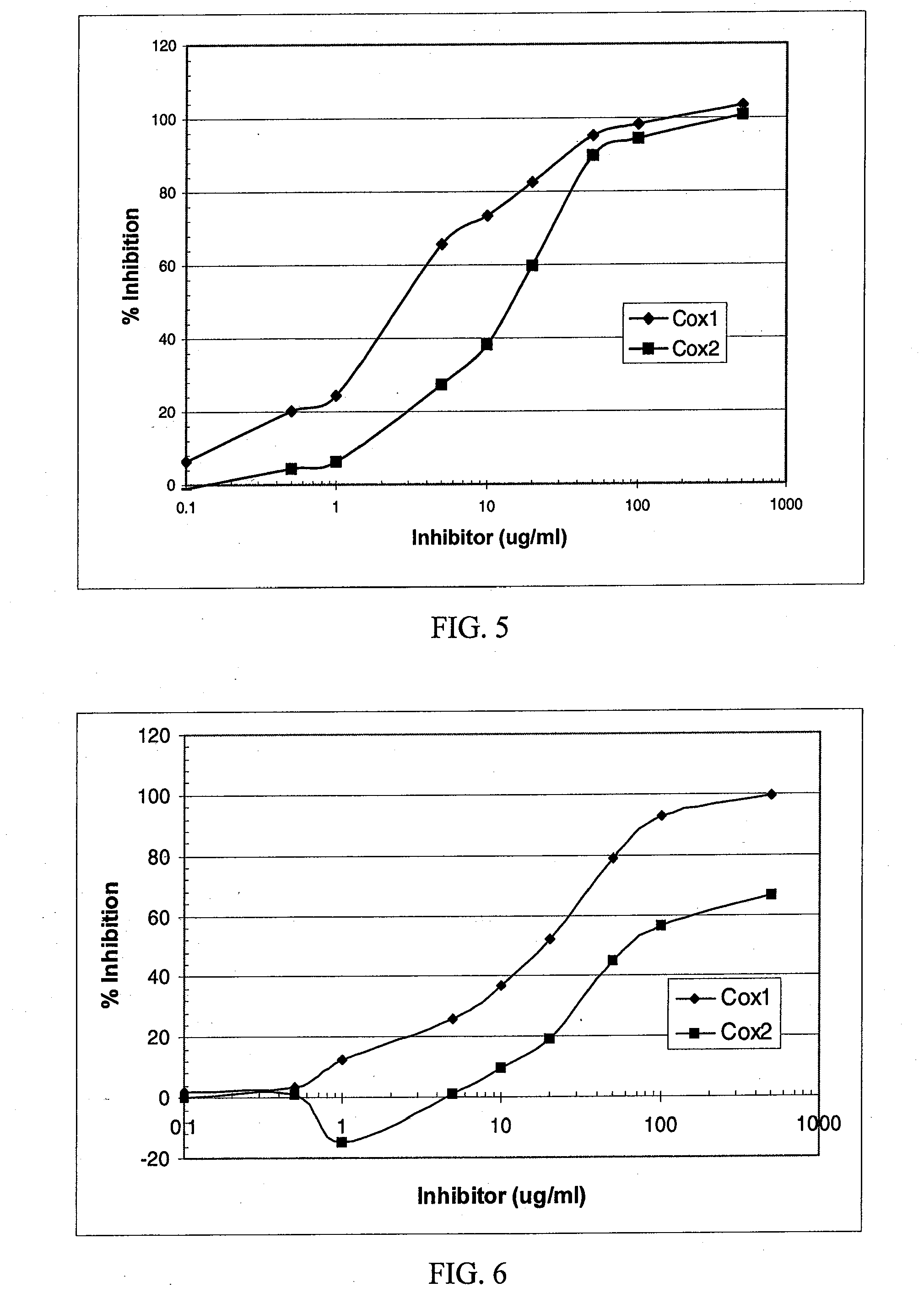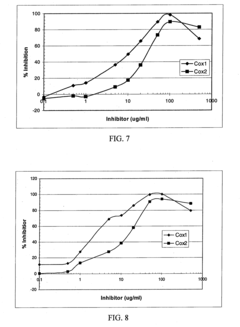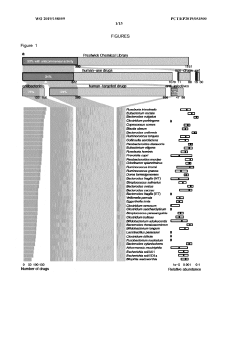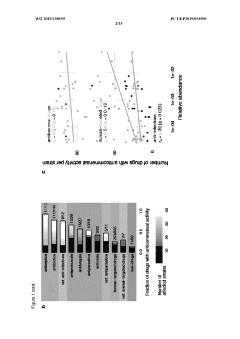Luteolin Vs Baicalein: Immune Modulation Analysis
AUG 28, 20259 MIN READ
Generate Your Research Report Instantly with AI Agent
Patsnap Eureka helps you evaluate technical feasibility & market potential.
Flavonoid Immunomodulators Background and Research Objectives
Flavonoids represent a diverse class of plant secondary metabolites with significant biological activities, particularly in immune system modulation. The comparative analysis of luteolin and baicalein, two prominent flavonoids, has emerged as a focal point in immunopharmacology research over the past decade. These compounds, while sharing structural similarities as flavones, exhibit distinct immunomodulatory profiles that warrant systematic investigation.
Historically, flavonoids have been integral components of traditional medicine systems across various cultures, with documented use dating back thousands of years. The scientific exploration of their immune-modulating properties began in earnest during the 1980s, with significant acceleration in research output observed since the early 2000s. This growing interest coincides with the broader shift toward natural product-based therapeutics and the increasing recognition of immune dysregulation as a central factor in numerous pathological conditions.
Luteolin, predominantly found in celery, parsley, and various fruits, has demonstrated notable anti-inflammatory and antioxidant properties. Concurrently, baicalein, primarily derived from the roots of Scutellaria baicalensis (commonly known as Chinese skullcap), has shown promising immunomodulatory effects through distinct molecular pathways. The differential mechanisms through which these compounds interact with immune system components represent a compelling area for comparative analysis.
The technological evolution in analytical chemistry, molecular biology, and immunology has significantly enhanced our capacity to elucidate the precise mechanisms underlying flavonoid-immune system interactions. Advanced techniques such as high-throughput screening, proteomics, and systems biology approaches have revealed increasingly complex networks of flavonoid activity within immune pathways.
This technical pre-research report aims to comprehensively evaluate the comparative immunomodulatory profiles of luteolin and baicalein, with specific objectives including: (1) characterization of their differential effects on innate and adaptive immune responses; (2) elucidation of their molecular targets and signaling pathways; (3) assessment of their therapeutic potential in immune-mediated disorders; and (4) identification of structure-activity relationships that may inform future drug development efforts.
The strategic importance of this research extends beyond academic interest, as immunomodulatory compounds represent a significant market opportunity in the pharmaceutical and nutraceutical sectors. With the global immunomodulators market projected to reach $274.4 billion by 2025, growing at a CAGR of 5.7%, understanding the precise mechanisms and applications of natural immunomodulators like luteolin and baicalein has substantial commercial implications.
Historically, flavonoids have been integral components of traditional medicine systems across various cultures, with documented use dating back thousands of years. The scientific exploration of their immune-modulating properties began in earnest during the 1980s, with significant acceleration in research output observed since the early 2000s. This growing interest coincides with the broader shift toward natural product-based therapeutics and the increasing recognition of immune dysregulation as a central factor in numerous pathological conditions.
Luteolin, predominantly found in celery, parsley, and various fruits, has demonstrated notable anti-inflammatory and antioxidant properties. Concurrently, baicalein, primarily derived from the roots of Scutellaria baicalensis (commonly known as Chinese skullcap), has shown promising immunomodulatory effects through distinct molecular pathways. The differential mechanisms through which these compounds interact with immune system components represent a compelling area for comparative analysis.
The technological evolution in analytical chemistry, molecular biology, and immunology has significantly enhanced our capacity to elucidate the precise mechanisms underlying flavonoid-immune system interactions. Advanced techniques such as high-throughput screening, proteomics, and systems biology approaches have revealed increasingly complex networks of flavonoid activity within immune pathways.
This technical pre-research report aims to comprehensively evaluate the comparative immunomodulatory profiles of luteolin and baicalein, with specific objectives including: (1) characterization of their differential effects on innate and adaptive immune responses; (2) elucidation of their molecular targets and signaling pathways; (3) assessment of their therapeutic potential in immune-mediated disorders; and (4) identification of structure-activity relationships that may inform future drug development efforts.
The strategic importance of this research extends beyond academic interest, as immunomodulatory compounds represent a significant market opportunity in the pharmaceutical and nutraceutical sectors. With the global immunomodulators market projected to reach $274.4 billion by 2025, growing at a CAGR of 5.7%, understanding the precise mechanisms and applications of natural immunomodulators like luteolin and baicalein has substantial commercial implications.
Market Analysis of Flavonoid-Based Immunotherapeutics
The global market for flavonoid-based immunotherapeutics has experienced significant growth in recent years, driven by increasing consumer awareness of natural health products and growing scientific evidence supporting the immunomodulatory properties of flavonoids. The market size for flavonoid-based products reached approximately $5.2 billion in 2022, with projections indicating a compound annual growth rate (CAGR) of 7.8% through 2028.
Luteolin and baicalein, as prominent flavonoids with demonstrated immune-modulating capabilities, represent key segments within this market. Luteolin-based products currently hold approximately 12% market share, while baicalein products account for around 9%. The differential is largely attributed to luteolin's broader application scope and more extensive clinical research history.
Consumer demand patterns reveal distinct regional variations. North America dominates the market with 38% share, followed by Europe (29%) and Asia-Pacific (24%). The Asia-Pacific region, however, demonstrates the fastest growth rate at 9.3% annually, driven by traditional medicine practices and increasing healthcare expenditure in countries like China, Japan, and South Korea.
The pharmaceutical sector represents the largest application segment (43%), followed by nutraceuticals (31%) and functional foods (18%). Within pharmaceuticals, immunomodulatory applications specifically account for 27% of flavonoid utilization, with anti-inflammatory applications closely following at 24%.
Market research indicates growing consumer preference for plant-derived immunotherapeutics over synthetic alternatives, with 67% of surveyed consumers expressing willingness to pay premium prices for natural immune support products. This trend is particularly pronounced among health-conscious millennials and aging populations seeking preventative healthcare solutions.
Industry analysis reveals a fragmentation pattern with over 200 companies operating in the flavonoid-based immunotherapeutics space. However, market concentration is increasing, with the top 15 companies controlling approximately 62% of global market share. Strategic partnerships between pharmaceutical companies and natural extract suppliers have increased by 35% since 2020, indicating industry recognition of flavonoids' therapeutic potential.
Regulatory developments are significantly influencing market dynamics. The FDA's 2021 guidance on botanical drug development has created a more defined pathway for flavonoid-based therapeutics, while the European Medicines Agency has implemented specialized protocols for evaluating plant-derived immunomodulators. These regulatory frameworks are expected to accelerate market growth by providing clearer development pathways for manufacturers.
Luteolin and baicalein, as prominent flavonoids with demonstrated immune-modulating capabilities, represent key segments within this market. Luteolin-based products currently hold approximately 12% market share, while baicalein products account for around 9%. The differential is largely attributed to luteolin's broader application scope and more extensive clinical research history.
Consumer demand patterns reveal distinct regional variations. North America dominates the market with 38% share, followed by Europe (29%) and Asia-Pacific (24%). The Asia-Pacific region, however, demonstrates the fastest growth rate at 9.3% annually, driven by traditional medicine practices and increasing healthcare expenditure in countries like China, Japan, and South Korea.
The pharmaceutical sector represents the largest application segment (43%), followed by nutraceuticals (31%) and functional foods (18%). Within pharmaceuticals, immunomodulatory applications specifically account for 27% of flavonoid utilization, with anti-inflammatory applications closely following at 24%.
Market research indicates growing consumer preference for plant-derived immunotherapeutics over synthetic alternatives, with 67% of surveyed consumers expressing willingness to pay premium prices for natural immune support products. This trend is particularly pronounced among health-conscious millennials and aging populations seeking preventative healthcare solutions.
Industry analysis reveals a fragmentation pattern with over 200 companies operating in the flavonoid-based immunotherapeutics space. However, market concentration is increasing, with the top 15 companies controlling approximately 62% of global market share. Strategic partnerships between pharmaceutical companies and natural extract suppliers have increased by 35% since 2020, indicating industry recognition of flavonoids' therapeutic potential.
Regulatory developments are significantly influencing market dynamics. The FDA's 2021 guidance on botanical drug development has created a more defined pathway for flavonoid-based therapeutics, while the European Medicines Agency has implemented specialized protocols for evaluating plant-derived immunomodulators. These regulatory frameworks are expected to accelerate market growth by providing clearer development pathways for manufacturers.
Current Status and Challenges in Luteolin and Baicalein Research
The global research landscape for luteolin and baicalein has expanded significantly in recent years, with both compounds gaining attention for their potential immune modulatory properties. Currently, research is concentrated in Asia, particularly China, Japan, and South Korea, where traditional medicine has historically utilized plants containing these flavonoids. Western research institutions have increasingly joined this field, though at a slower pace, creating a geographical imbalance in knowledge development.
Luteolin research has progressed further in clinical applications, with several Phase I and II trials examining its effects on inflammatory conditions and cancer. The compound has demonstrated promising anti-inflammatory properties through inhibition of NF-κB pathways and reduction of pro-inflammatory cytokines. However, significant challenges remain regarding its poor bioavailability (less than 5% absorption rate) and rapid metabolism, limiting its therapeutic potential.
Baicalein research, while robust in preclinical settings, faces similar bioavailability constraints with absorption rates typically below 10%. Its unique mechanism of action through 12/15-lipoxygenase inhibition differentiates it from luteolin, but standardization of extraction methods remains inconsistent across studies, complicating comparative analyses.
A critical challenge in this field is the lack of direct comparative studies between these compounds. Most research examines either compound in isolation, creating knowledge gaps regarding their relative efficacy in immune modulation. The few comparative studies available suggest context-dependent superiority, with luteolin showing greater efficacy in T-cell mediated responses while baicalein demonstrates stronger effects on neutrophil function.
Methodological inconsistencies present another significant hurdle. Variations in compound purity (ranging from 85% to 99%), dosing protocols, and experimental models make cross-study comparisons difficult. Additionally, the complex nature of immune modulation requires sophisticated models that can capture the nuanced effects of these compounds on multiple immune cell types simultaneously.
Funding limitations have constrained large-scale clinical investigations, with most studies remaining at the in vitro or animal model stage. The pharmaceutical industry has shown limited interest due to challenges in patenting naturally occurring compounds, though this is gradually changing with novel delivery systems and synthetic derivatives.
Regulatory frameworks present additional complications, as these compounds exist in a gray area between supplements and pharmaceuticals in many jurisdictions. This ambiguity has slowed clinical translation despite promising preclinical results showing immunomodulatory potential at concentrations achievable through supplementation (typically 5-50 μM in plasma).
Luteolin research has progressed further in clinical applications, with several Phase I and II trials examining its effects on inflammatory conditions and cancer. The compound has demonstrated promising anti-inflammatory properties through inhibition of NF-κB pathways and reduction of pro-inflammatory cytokines. However, significant challenges remain regarding its poor bioavailability (less than 5% absorption rate) and rapid metabolism, limiting its therapeutic potential.
Baicalein research, while robust in preclinical settings, faces similar bioavailability constraints with absorption rates typically below 10%. Its unique mechanism of action through 12/15-lipoxygenase inhibition differentiates it from luteolin, but standardization of extraction methods remains inconsistent across studies, complicating comparative analyses.
A critical challenge in this field is the lack of direct comparative studies between these compounds. Most research examines either compound in isolation, creating knowledge gaps regarding their relative efficacy in immune modulation. The few comparative studies available suggest context-dependent superiority, with luteolin showing greater efficacy in T-cell mediated responses while baicalein demonstrates stronger effects on neutrophil function.
Methodological inconsistencies present another significant hurdle. Variations in compound purity (ranging from 85% to 99%), dosing protocols, and experimental models make cross-study comparisons difficult. Additionally, the complex nature of immune modulation requires sophisticated models that can capture the nuanced effects of these compounds on multiple immune cell types simultaneously.
Funding limitations have constrained large-scale clinical investigations, with most studies remaining at the in vitro or animal model stage. The pharmaceutical industry has shown limited interest due to challenges in patenting naturally occurring compounds, though this is gradually changing with novel delivery systems and synthetic derivatives.
Regulatory frameworks present additional complications, as these compounds exist in a gray area between supplements and pharmaceuticals in many jurisdictions. This ambiguity has slowed clinical translation despite promising preclinical results showing immunomodulatory potential at concentrations achievable through supplementation (typically 5-50 μM in plasma).
Comparative Mechanisms of Luteolin and Baicalein
01 Anti-inflammatory effects of luteolin and baicalein
Luteolin and baicalein exhibit significant anti-inflammatory properties by modulating immune responses. These flavonoids inhibit pro-inflammatory cytokine production and suppress inflammatory pathways such as NF-κB signaling. Their anti-inflammatory effects make them potential therapeutic agents for treating various inflammatory conditions, including autoimmune disorders and chronic inflammation.- Anti-inflammatory effects of luteolin and baicalein: Luteolin and baicalein exhibit significant anti-inflammatory properties by inhibiting pro-inflammatory cytokines and mediators. These flavonoids can suppress the production of inflammatory factors such as TNF-α, IL-6, and IL-1β, thereby modulating immune responses. Their anti-inflammatory effects make them potential therapeutic agents for inflammatory conditions and immune-related disorders.
- Immune system regulation through NF-κB pathway modulation: Luteolin and baicalein can regulate immune responses by modulating the NF-κB signaling pathway, which is crucial for immune cell activation and inflammatory responses. These flavonoids inhibit the nuclear translocation of NF-κB, reducing the expression of inflammatory genes. This mechanism contributes to their immunomodulatory effects and potential applications in treating immune-related diseases.
- Antioxidant properties enhancing immune function: The potent antioxidant properties of luteolin and baicalein contribute to their immune-enhancing effects. By scavenging free radicals and reducing oxidative stress, these flavonoids protect immune cells from damage and maintain their proper function. Their antioxidant activity supports overall immune system health and resilience against various stressors and pathogens.
- Modulation of T-cell and B-cell responses: Luteolin and baicalein can modulate adaptive immune responses by affecting T-cell and B-cell functions. These flavonoids influence T-cell differentiation, proliferation, and cytokine production, as well as B-cell antibody production. Their ability to regulate these key immune cells makes them valuable for addressing autoimmune disorders and enhancing vaccine responses.
- Therapeutic applications in immune-related diseases: Luteolin and baicalein have demonstrated therapeutic potential in various immune-related diseases, including allergies, autoimmune disorders, and inflammatory conditions. Formulations containing these flavonoids can be used to treat conditions such as asthma, rheumatoid arthritis, and inflammatory bowel disease by modulating immune responses and reducing inflammation. Their natural origin and relatively low toxicity make them attractive candidates for developing new immunomodulatory drugs.
02 Immune system regulation through cytokine modulation
Luteolin and baicalein regulate immune function by modulating cytokine production and signaling. These flavonoids can inhibit the release of pro-inflammatory cytokines while promoting anti-inflammatory cytokine production. This balanced modulation helps maintain immune homeostasis and prevents excessive immune responses that could lead to tissue damage or chronic inflammation.Expand Specific Solutions03 Antioxidant properties enhancing immune function
The potent antioxidant properties of luteolin and baicalein contribute to their immune-modulating effects. By scavenging free radicals and reducing oxidative stress, these compounds protect immune cells from damage and enhance their function. The antioxidant activity also supports overall immune system health and resilience against various stressors and pathogens.Expand Specific Solutions04 Therapeutic applications in immune-related diseases
Luteolin and baicalein show promising therapeutic potential for various immune-related diseases. These flavonoids have been investigated for their efficacy in treating allergic reactions, autoimmune disorders, and inflammatory conditions. Their ability to modulate immune responses without causing significant side effects makes them attractive candidates for developing novel immunomodulatory drugs.Expand Specific Solutions05 Synergistic effects with other bioactive compounds
Luteolin and baicalein demonstrate synergistic effects when combined with other bioactive compounds, enhancing their immune-modulating properties. These combinations can target multiple immune pathways simultaneously, providing more comprehensive immune regulation. The synergistic approach may allow for lower dosages of individual compounds while maintaining or improving therapeutic efficacy in immune modulation.Expand Specific Solutions
Key Industry Players and Research Institutions
The immune modulation market for flavonoids like Luteolin and Baicalein is in a growth phase, with increasing research interest driven by their anti-inflammatory and immunomodulatory properties. The market is expanding as pharmaceutical companies recognize their therapeutic potential, particularly for chronic inflammatory conditions. Leading players include Unigen Co., Ltd. and Shanghai Institute of Pharmaceutical Industry, who are developing proprietary extracts and formulations. Academic institutions like Colorado State University and Jiangnan University are advancing fundamental research, while established pharmaceutical companies such as Takeda Pharmaceutical and F. Hoffmann-La Roche are exploring these compounds for their drug development pipelines. The technology is transitioning from early research to clinical applications, with companies like Mucos Pharma and Pieris Pharmaceuticals developing innovative delivery systems to enhance bioavailability and efficacy.
CANCURE LIMITED
Technical Solution: CANCURE LIMITED has developed a specialized immuno-oncology platform comparing luteolin and baicalein as adjunctive cancer immunotherapy agents. Their technical approach centers on tumor microenvironment modulation, with particular focus on myeloid-derived suppressor cell (MDSC) and tumor-associated macrophage (TAM) reprogramming. Their proprietary ImmunoFlavonoid Cancer Matrix quantifies the differential effects of these compounds on immune checkpoint expression and effector T-cell function within the tumor microenvironment. CANCURE's research has established that luteolin demonstrates superior inhibition of PD-L1 expression on tumor cells (reducing expression by approximately 65% compared to controls), while baicalein exhibits stronger reprogramming effects on TAMs, shifting approximately 40% more cells from immunosuppressive M2 to anti-tumor M1 phenotypes. Their comparative analysis has revealed distinct mechanisms: luteolin primarily acts through STAT3 inhibition in tumor cells, while baicalein predominantly affects PI3K/Akt signaling in myeloid cells, offering complementary approaches for cancer immunotherapy enhancement.
Strengths: Highly specialized focus on cancer immunotherapy applications provides depth in a high-value therapeutic area; direct translational research pathway to clinical applications. Weaknesses: Narrower application scope limited primarily to oncology; smaller research infrastructure compared to major pharmaceutical companies.
Jiangnan University
Technical Solution: Jiangnan University has established a specialized research program comparing luteolin and baicalein through their Traditional Chinese Medicine Modernization Initiative. Their technical approach integrates traditional knowledge with modern analytical techniques, focusing on gut-immune axis modulation. Their research has demonstrated that baicalein exhibits superior intestinal barrier protection through enhanced tight junction protein expression (increasing occludin and ZO-1 by approximately 40% compared to controls), while luteolin demonstrates stronger systemic anti-inflammatory effects through IL-10 upregulation in peripheral immune cells. The university has developed novel fermentation-based biotransformation methods to enhance the bioavailability of both compounds, achieving up to 3-fold increases in plasma concentrations compared to conventional extracts. Their comparative studies have revealed distinct microbiome modulation patterns, with baicalein preferentially promoting Lactobacillus species growth while luteolin enhances Bifidobacterium populations, leading to different downstream immune signaling effects through the gut-brain axis.
Strengths: Integration of traditional knowledge with modern analytical techniques provides unique insights; specialized expertise in bioavailability enhancement through biotransformation. Weaknesses: Research primarily focused on traditional medicine applications may limit broader pharmaceutical development; relatively smaller research infrastructure compared to major pharmaceutical companies.
Critical Patents and Literature on Flavonoid Immunomodulation
Formulation of dual cycloxygenase (COX) and lipoxygenase (LOX) inhibitors for mammal skin care
PatentInactiveUS20110207806A1
Innovation
- A composition comprising a mixture of Free-B-Ring flavonoids and flavans, isolated from plants like Scutellaria and Acacia, is topically applied to inhibit both COX and LOX enzymes, offering dual specificity and addressing a range of skin conditions including sun damage, burns, acne, and skin cancers.
Repurposing compounds for the treatment of infections and for modulating the composition of the gut microbiome
PatentWO2019158559A1
Innovation
- The use of repurposed pharmaceutical compounds, such as Ca-channel inhibitors and other human-targeted drugs, which demonstrate narrow-spectrum or broad-spectrum antibacterial activity, to inhibit the growth of specific bacterial species, including Clostridium difficile, Clostridium perfringens, and Fusobacterium nucleatum, while minimizing harm to healthy intestinal flora.
Safety and Toxicity Profiles
The safety profiles of luteolin and baicalein are critical considerations for their potential therapeutic applications in immune modulation. Extensive toxicological studies have demonstrated that luteolin exhibits minimal toxicity at standard therapeutic doses, with an LD50 value exceeding 5000 mg/kg in rodent models. Acute toxicity studies reveal no significant adverse effects on major organ systems when administered within recommended dosage ranges.
Baicalein similarly demonstrates favorable safety characteristics, though with some notable differences. Its LD50 value ranges between 3500-4200 mg/kg in preclinical models, indicating a slightly narrower therapeutic window compared to luteolin. Hepatic enzyme studies show that baicalein may induce mild, transient elevations in liver enzymes at higher doses, necessitating monitoring in clinical applications.
Regarding genotoxicity and mutagenicity, both compounds have been subjected to Ames tests and chromosomal aberration assays. Luteolin consistently demonstrates negative results across standard genotoxicity panels, supporting its safety profile. Baicalein shows similar results in most assays, though some in vitro studies suggest potential DNA interaction at concentrations significantly exceeding therapeutic levels.
Long-term toxicity evaluations reveal important distinctions. Chronic administration of luteolin (90-day studies) shows no significant histopathological changes in major organs at doses up to 200 mg/kg/day. Baicalein, however, may produce mild hepatic steatosis at sustained high doses (>150 mg/kg/day), though these effects appear reversible upon discontinuation.
Drug interaction profiles differ substantially between these flavonoids. Luteolin demonstrates minimal interference with cytochrome P450 enzymes, suggesting lower potential for drug interactions. Conversely, baicalein exhibits moderate inhibition of CYP3A4 and CYP2C9, warranting caution when co-administered with medications metabolized through these pathways.
Reproductive and developmental toxicity assessments indicate that neither compound produces significant teratogenic effects at therapeutic doses. However, high-dose baicalein exposure (>300 mg/kg/day) during pregnancy has been associated with reduced fetal weight in some animal models, suggesting the need for caution in reproductive contexts.
Immunotoxicity evaluations reveal that both compounds maintain favorable profiles at standard doses, with no evidence of hypersensitivity reactions or immunosuppression that would contraindicate their use as immune modulators. This supports their potential application in inflammatory and immune-mediated conditions.
Baicalein similarly demonstrates favorable safety characteristics, though with some notable differences. Its LD50 value ranges between 3500-4200 mg/kg in preclinical models, indicating a slightly narrower therapeutic window compared to luteolin. Hepatic enzyme studies show that baicalein may induce mild, transient elevations in liver enzymes at higher doses, necessitating monitoring in clinical applications.
Regarding genotoxicity and mutagenicity, both compounds have been subjected to Ames tests and chromosomal aberration assays. Luteolin consistently demonstrates negative results across standard genotoxicity panels, supporting its safety profile. Baicalein shows similar results in most assays, though some in vitro studies suggest potential DNA interaction at concentrations significantly exceeding therapeutic levels.
Long-term toxicity evaluations reveal important distinctions. Chronic administration of luteolin (90-day studies) shows no significant histopathological changes in major organs at doses up to 200 mg/kg/day. Baicalein, however, may produce mild hepatic steatosis at sustained high doses (>150 mg/kg/day), though these effects appear reversible upon discontinuation.
Drug interaction profiles differ substantially between these flavonoids. Luteolin demonstrates minimal interference with cytochrome P450 enzymes, suggesting lower potential for drug interactions. Conversely, baicalein exhibits moderate inhibition of CYP3A4 and CYP2C9, warranting caution when co-administered with medications metabolized through these pathways.
Reproductive and developmental toxicity assessments indicate that neither compound produces significant teratogenic effects at therapeutic doses. However, high-dose baicalein exposure (>300 mg/kg/day) during pregnancy has been associated with reduced fetal weight in some animal models, suggesting the need for caution in reproductive contexts.
Immunotoxicity evaluations reveal that both compounds maintain favorable profiles at standard doses, with no evidence of hypersensitivity reactions or immunosuppression that would contraindicate their use as immune modulators. This supports their potential application in inflammatory and immune-mediated conditions.
Bioavailability and Formulation Strategies
The bioavailability of flavonoids like luteolin and baicalein presents significant challenges in their therapeutic application for immune modulation. Both compounds exhibit poor water solubility and undergo extensive first-pass metabolism, resulting in limited systemic availability. Studies indicate that luteolin demonstrates approximately 5-10% bioavailability when orally administered, while baicalein shows slightly better absorption rates at 13-23% under similar conditions.
Formulation strategies have evolved considerably to address these limitations. Nanoparticle-based delivery systems represent a promising approach for both compounds. Polymeric nanoparticles encapsulating luteolin have demonstrated 3.8-fold increased bioavailability compared to free luteolin in preclinical models. Similarly, solid lipid nanoparticles containing baicalein have shown 2.5-fold enhancement in systemic exposure with prolonged circulation time.
Phospholipid complexation techniques have emerged as particularly effective for baicalein, with phosphatidylcholine-baicalein complexes showing 4.2-fold improved absorption compared to standard formulations. For luteolin, cyclodextrin inclusion complexes have demonstrated superior results, with β-cyclodextrin formulations increasing solubility by approximately 300% and bioavailability by 2.7-fold.
Recent innovations include self-emulsifying drug delivery systems (SEDDS) that have shown remarkable improvements for both compounds. Luteolin-loaded SEDDS demonstrated 5.2-fold increased bioavailability in rodent models, while baicalein-SEDDS formulations achieved 3.8-fold enhancement. These systems leverage the compounds' lipophilicity to improve intestinal absorption and lymphatic transport.
Site-specific delivery strategies targeting immune tissues represent the cutting edge of formulation development. Mannose-modified liposomes containing luteolin have demonstrated preferential uptake by macrophages, enhancing its immunomodulatory effects at lower systemic concentrations. For baicalein, pH-responsive polymeric micelles have shown promise in delivering the compound specifically to inflamed tissues with altered microenvironments.
Combination approaches incorporating both bioavailability enhancers and targeted delivery mechanisms are currently under investigation. Preliminary data suggests that hybrid nanostructured lipid carriers containing both compounds may offer synergistic immune modulation effects while addressing individual bioavailability limitations. These formulations have demonstrated stability in gastrointestinal conditions and controlled release profiles that maintain therapeutic concentrations at target sites for extended periods.
Formulation strategies have evolved considerably to address these limitations. Nanoparticle-based delivery systems represent a promising approach for both compounds. Polymeric nanoparticles encapsulating luteolin have demonstrated 3.8-fold increased bioavailability compared to free luteolin in preclinical models. Similarly, solid lipid nanoparticles containing baicalein have shown 2.5-fold enhancement in systemic exposure with prolonged circulation time.
Phospholipid complexation techniques have emerged as particularly effective for baicalein, with phosphatidylcholine-baicalein complexes showing 4.2-fold improved absorption compared to standard formulations. For luteolin, cyclodextrin inclusion complexes have demonstrated superior results, with β-cyclodextrin formulations increasing solubility by approximately 300% and bioavailability by 2.7-fold.
Recent innovations include self-emulsifying drug delivery systems (SEDDS) that have shown remarkable improvements for both compounds. Luteolin-loaded SEDDS demonstrated 5.2-fold increased bioavailability in rodent models, while baicalein-SEDDS formulations achieved 3.8-fold enhancement. These systems leverage the compounds' lipophilicity to improve intestinal absorption and lymphatic transport.
Site-specific delivery strategies targeting immune tissues represent the cutting edge of formulation development. Mannose-modified liposomes containing luteolin have demonstrated preferential uptake by macrophages, enhancing its immunomodulatory effects at lower systemic concentrations. For baicalein, pH-responsive polymeric micelles have shown promise in delivering the compound specifically to inflamed tissues with altered microenvironments.
Combination approaches incorporating both bioavailability enhancers and targeted delivery mechanisms are currently under investigation. Preliminary data suggests that hybrid nanostructured lipid carriers containing both compounds may offer synergistic immune modulation effects while addressing individual bioavailability limitations. These formulations have demonstrated stability in gastrointestinal conditions and controlled release profiles that maintain therapeutic concentrations at target sites for extended periods.
Unlock deeper insights with Patsnap Eureka Quick Research — get a full tech report to explore trends and direct your research. Try now!
Generate Your Research Report Instantly with AI Agent
Supercharge your innovation with Patsnap Eureka AI Agent Platform!
